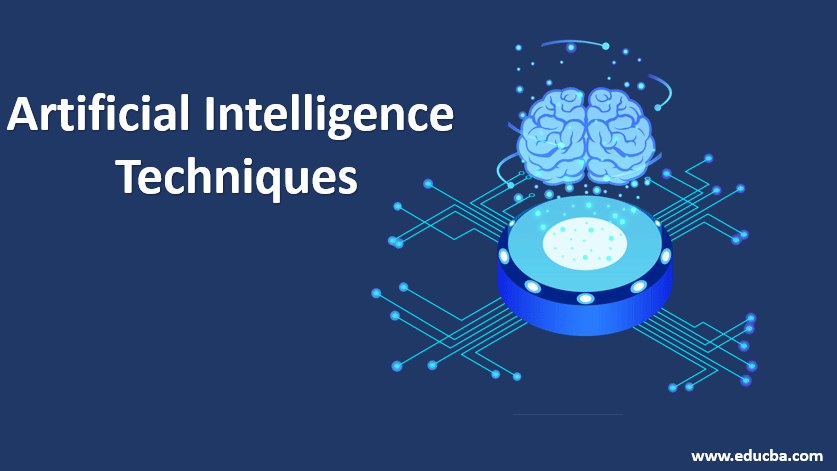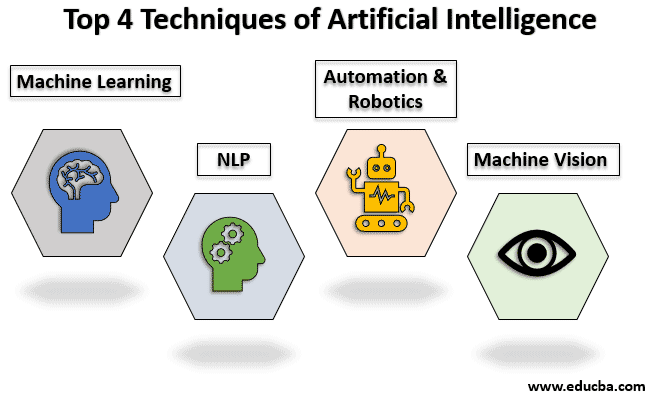
Introduction to What is Artificial Intelligence?
AI is the computer science field that creates machines mimicking human intelligence, using algorithms to simulate human-like behavior and decision-making. In AI development services, machines perform tasks like speech recognition, problem-solving, Learning, etc. Machines can work and act like a human if they have enough information. So in artificial intelligence, knowledge engineering plays a vital role. Knowledge engineering involves establishing the relationship between objects and their properties. Below are the techniques of Artificial Intelligence.
Top 4 Techniques of Artificial Intelligence
Artificial Intelligence can be divided into categories based on the machine’s capacity to use past experiences to predict future decisions, memory, and self-awareness. IBM came up with Deep Blue, a chess program that can identify the pieces in the chessboard. But it does not have the memory to predict future actions. This system, though valuable, is not adaptable to other situations. Another type of AI system uses past experiences and has the bonus of a limited memory to predict decisions.
The decision-making functions in self-driving cars provide an example of this type of AI system. Here the observations help in the actions to be taken shortly, which are not stored permanently as the statements change frequently. As technology advances, it may become possible for machines to possess a sense of consciousness that enables them to understand the current state of affairs and infer what needs to be done. But such systems do not exist.
Below are the various categories of Artificial Intelligence:

1. Machine Learning
It is one of the applications of AI where machines are not explicitly programmed to perform specific tasks; instead, they learn and improve from experience automatically. Deep Learning is a subset of machine learning based on artificial neural networks for predictive analysis. There are various machine learning algorithms, such as Unsupervised, Supervised, and Reinforcement Learning. In Unsupervised Learning, the algorithm does not use classified information to act on it without any guidance. Supervised Learning deduces a function from the training data, consisting of an input object and the desired output. Machines use reinforcement learning to take suitable actions to increase the reward to find the best possible, which should be considered. MIT’s AI course is renowned for its comprehensive coverage of these machine learning concepts and their applications in various fields.
2. NLP (Natural Language Processing)
Natural Language Processing involves programming computers to process human languages to facilitate interactions between humans and computers. Machine Learning is a reliable technology for Natural Language Processing to obtain meaning from human languages. In NLP, the machine captures the audio of a human talk. After the audio-to-text conversion, the text is processed and converted back into audio data. Then the machine uses the audio to respond to humans. Applications of Natural Language Processing can be found in IVR systems and applications used in call centers, language translation applications like Google Translate, and word processors such as Microsoft Word to check the accuracy of grammar in text.
However, the nature of human languages makes Natural Language Processing difficult because of the rules involved in passing information using natural language. They are challenging for computers to understand. NLP leverages algorithms to recognize and abstract the rules of natural languages, converting unstructured human language data into a computer-understandable format. Moreover, NLP can also be found in content optimization, such as paraphrasing applications, which helps to improve the readability of complex text.
3. Automation and Robotics
Automation aims to improve productivity and efficiency by having machines perform monotonous and repetitive tasks, resulting in cost-effective outcomes. Many organizations use machine learning, neural networks, and graphs in automation. Using CAPTCHA technology, such automation can prevent fraud issues during online financial transactions. Programmers create robotic process automation to perform high-volume repetitive tasks that can adapt to changes in different circumstances.
4. Machine Vision
Machines can capture visual information and then analyze it. This process involves using cameras to capture visual information, converting the analog image to digital data, and processing the data through digital signal processing. Then the resulting data is fed to a computer. In machine vision, two vital aspects are sensitivity, the ability to perceive weak impulses, and resolution, the range to which the machine can distinguish objects. The usage of machine vision can be found in signature identification, pattern recognition, medical image analysis, etc.
Applications of Artificial Intelligence
Below are the various applications of artificial intelligence.
- The finance industry uses AI to collect personal data that it can later use to provide financial advice.
- Educators utilize an AI certificate course to learn how to apply AI to automate the grading system, assess student performance, and integrate AI-powered proctoring solutions to ensure secure and fair assessments, thereby enhancing the learning process.
- Artists use AI to enhance creativity and automate tasks. For example, in tattoo artistry, AI helps generate custom tattoos by analyzing client preferences, allowing tattoo artists to offer unique, personalized patterns. Artists can also use AI Image Generators and tools like Photoshop Online Editor to create custom images, refine their designs, and enhance their creative process.
- The healthcare industry uses AI to diagnose better using technologies that understand natural language and respond to questions. Also, computer programs like AI-powered chatbots assist customers in scheduling appointments and ease billing.
- Businesses use AI to automate repetitive tasks that humans perform with the help of Robotic Process Automation. Integrating machine learning algorithms with analytics enables the gathering of customer information to understand their needs better, ultimately increasing customer satisfaction.
- With AI, businesses can create animated content with hand, body, and mouth animation, which helps them create effective campaigns.
- AI finds applications in various areas, including smart home devices, security and surveillance, navigation and travel, media streaming, video games, and music creation with AI music makers like Tad AI.
- Marketing teams leverage the photoshop online editor to create high-quality visuals for advertisements, enhancing the appeal and effectiveness of their marketing campaigns.
Conclusion
However, AI is impacting our lives on a grand scale. Organizations also are taking steps towards adapting to AI technology, which can give them new ways of performing tasks and understanding the data pattern to maximize productivity.
Recommended Articles
This is a guide to Artificial Intelligence Techniques. Here we discuss Artificial Intelligence and its Techniques, along with its Applications. You can also go through our other suggested articles to learn more –


